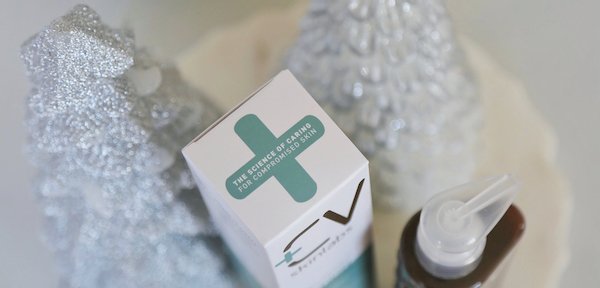[ad_1]
Have you heard beauty companies talking about skin-identical ingredients?
If so, you may have wondered what they are.
Let us explain.
What Are Skin-Identical Ingredients?
The term “skin-identical” is a relatively new one in the beauty industry. The idea is that these ingredients are similar to those already found in the skin. That means that the skin can more readily and efficiently absorb and use them.
If you think about a child’s skin, you can see that the skin starts with everything it needs to look its best. It’s smooth, soft, and flawless.
As we rack up the years, the skin tends to suffer a lot of wear and tear. It can start to struggle to keep up with repair requirements. Plus, the older we get, the less efficient the skin is at producing collagen, elastin, and the other ingredients it needs to look its best.
Skin can also become oversensitized to certain things over time. It may develop allergies to fragrances or preservatives, start to react more to pollen and other allergens, or break out more easily when you use harsh scrubs or other products.
That’s why as we age, it helps to give the skin back some of those helpful and reparative ingredients it had in its youth. Feeding the skin the things that it once produced so well on its own can help it continue to look healthy and youthful even as we get older.
These are skin-identical ingredients—ingredients that are so similar to the ones the skin used to make (or still makes to some degree) that it recognizes them instantly and can use them right away.

What Do Skin-Identical Ingredients Do?
When you use skin-identical ingredients in your skincare routine, you support your skin’s natural function with compounds that it recognizes and needs. Having enough of these ingredients helps improve the skin’s ability to renew, refine, and repair itself for an age-defiant complexion.
Since skin-identical ingredients are either the same or similar to those found naturally within the skin, they are instantly recognized when applied topically. The skin knows how to use them and does so in an efficient manner.
Having skin-identical ingredients in your skincare products also lowers the risk that you may suffer from any reactions. Even sensitive skin does well with skin-identical ingredients, as it recognizes them and is unlikely to see them as dangerous or harmful.
When you regularly use skin-identical ingredients, you’ll notice the following benefits:
- Increased hydration
- Enhanced barrier function
- Longer-lasting plumpness
- Antioxidant protection
- Delayed appearance of aging
- Less noticeable fine lines and wrinkles
- Reduced skin roughness
- Restored skin suppleness
- Improved skin conditions like eczema, rosacea, and psoriasis
- Reduced skin reactivity and sensitivity
Types of Skin-Identical Ingredients
The skin itself is made up of the following:
- Sebum: Sebum is the skin’s natural oil or moisturizer. It is made up of 45 percent triglycerides, 25 percent wax esters, 12 percent squalene, 10 percent fatty acids, and 4 percent cholesterol.
- Epidermis: This is the outer layer of the skin. It’s made up of about 30-35 percent fatty acids, 30-35 percent ceramides, and 30-35 percent cholesterol.
Based on what we know so far about the skin and what we’ve been able to create in terms of skincare ingredients, you can find skin-identical ingredients in the following categories.
Fatty Acids
These help keep the skin soft and supple, moisturizing and smoothing the outer layer. They also act as anti-inflammatory agents, reverse skin sensitivity, aid in wound healing, and protect photo-aging. Fatty acids like those found in the skin are also present in natural oils, butters, squalene, and waxes.
Ceramides
Ceramides (lipids) are a class of fatty acids that make up about 50 percent of the outer skin barrier. Healthy skin contains a lot of them, but they do decrease as we age. This leads to dry skin and an impaired barrier. When you have enough ceramides, they provide an effective barrier against water loss and help the skin protect itself from pathogens and UV radiation.
Cholesterol
Another type of fat, cholesterol helps keep the outer layer moisturized while trapping moisture so it can’t escape. It’s one of the main lipids (fats) found in the skin, playing a role in maintaining barrier integrity.
Natural Moisturizing Factor
This is part of the skin’s own sebum. It’s made up of components that attract and bind water from the atmosphere, drawing it into the cells. Ingredients that mimic the action of these components include:
- Hyaluronic acid: This compound binds to water and holds it to the skin. It’s found in small amounts within the skin, helping to keep the outer wall of cells moisturized.
- Glycerin: This moisturizer also helps retain water, keeping the skin nicely hydrated.
- Proteins and amino acids: Structural proteins within the skin naturally decrease over time. Replenishing these proteins can help support collagen synthesis and rebuild the structural matrix.

Common Skin-Identical Ingredients
Some common skin-identical ingredients you may find listed on the ingredient label are:
- Squalane
- Ceramides
- Cholesterol
- Hyaluronic acid
- Phospholipids
- Natural oils
- Natural butters (shea butter)
- Proline
- Glycerin
- Amino acids
- Vitamin E
- Sodium PCA
- Acetyl glucosamine
All of our products at CV Skinlabs are formulated with skin-identical ingredients. These formulas allow the skin to receive the nutrients it needs without irritation, sensitization, toxicity, or other side effects. Plus, the solutions strengthen the outer barrier, helping to protect the skin while keeping it moisturized and radiant.
If your skin is dry, irritated, sensitive, suffering from acne flare-ups, red, inflamed, or aging fast, give our products a try. Your skin will be able to absorb and utilize them quickly, and you’re likely to notice a change for the better within just a few weeks!
Did you know what skin-identical ingredients were?
[ad_2]
Source link











